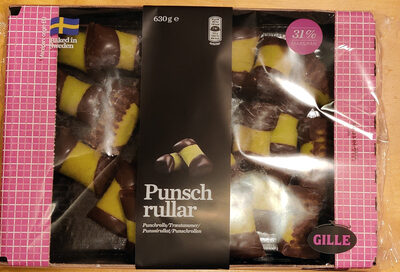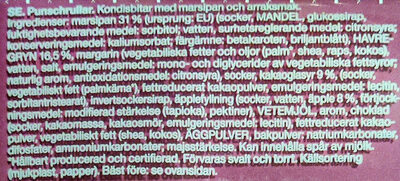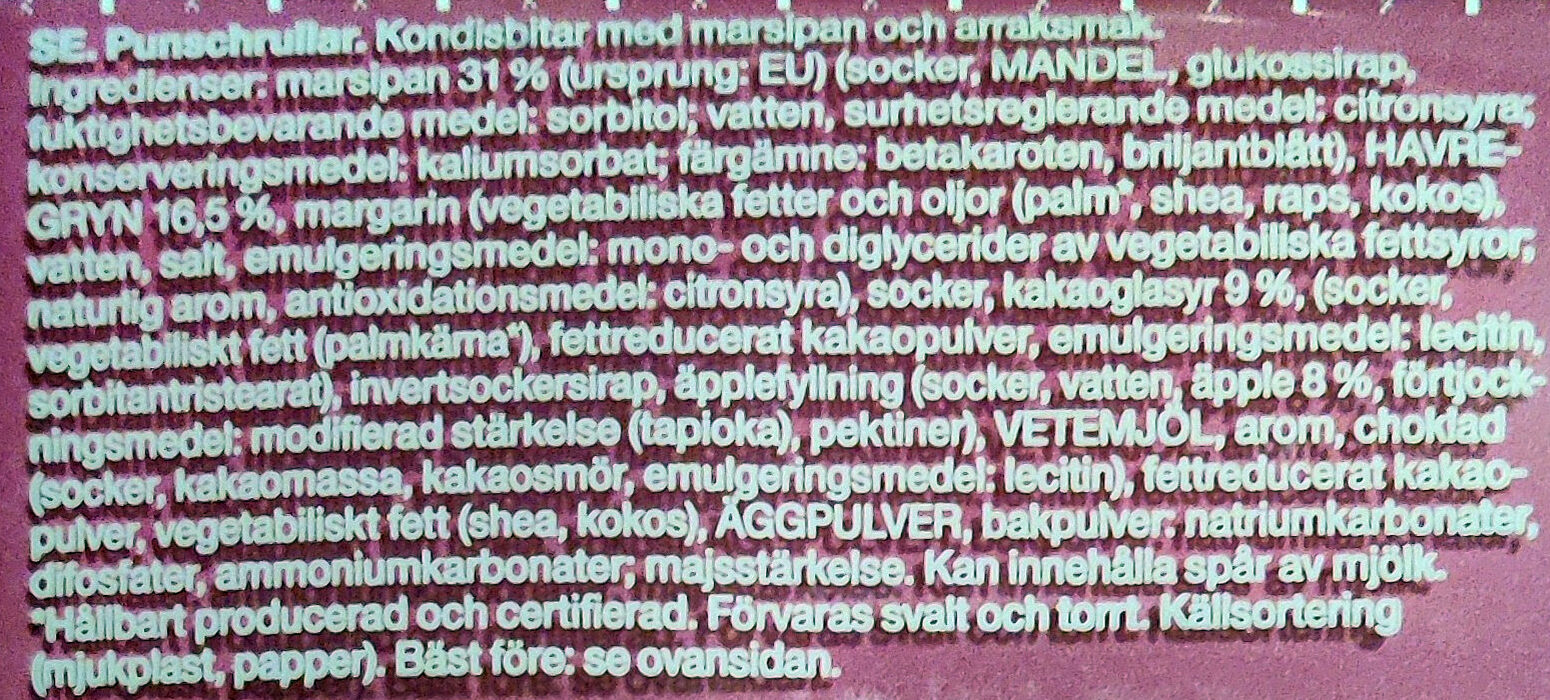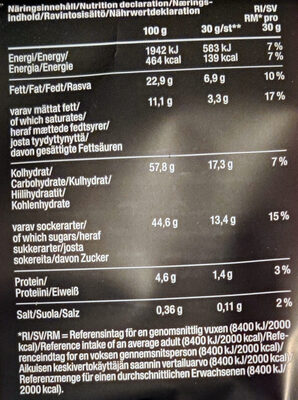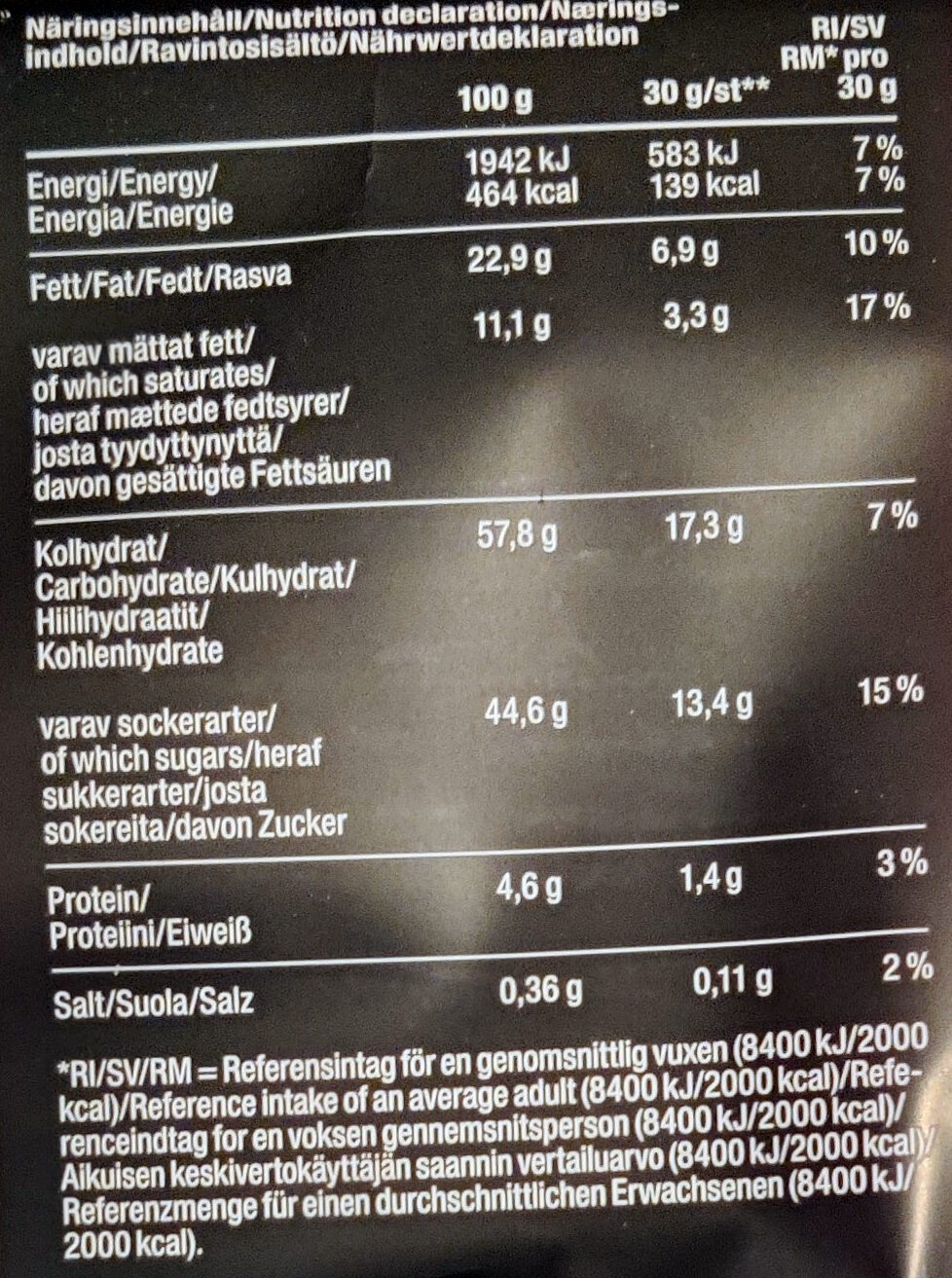Help us make food transparency the norm!
As a non-profit organization, we depend on your donations to continue informing consumers around the world about what they eat.
The food revolution starts with you!
Punchrullar - Gille - 630 g
Punchrullar - Gille - 630 g
Streckkod: 7314710550018 (EAN / EAN-13)
Kvantitet: 630 g
Förpackning: Plast, Papper, Mjukplast
Varumärken: Gille
Kategorier: Snacks, Söta snacks, Kakor och tårtor, en:Pastries
Origin of the product and/or its ingredients: Sverige, EU.
Ingredients ursprung: Europeiska unionen
Tillverknings eller bearbetningsplats: Sverige, Sweden
Butiker: City Gross
Länder där såld: Sverige
Matching with your preferences
Hälsa
Ingredienser
-
62 ingredienser
Marsipan 31 % (socker, MANDEL, glukossirap, fuktighetsbevarande medel: sorbitol; vatten, surhetsreglerande medel: citronsyra konserveringsmedel: kaliumsorbat; färgämne: betakaroten, briljantblått), HAVREGRYN 16,5%, margarin (vegetabiliska fetter och oljor (palm, shea, raps, kokos) vatten, salt, emulgeringsmedel: mono-och diglycerider av vegetabiliska fettsyror, naturlig arom, antioxidationsmedel: citronsyra), socker, kakaoglasyr 9%, (socker, vegetabiliskt fett (palmkäma), fettreducerat kakaopulver, emulgeringsmedel: lecitin, sorbitantristearat), invertsockersirap, Äpplefyllning (socker, vatten äpple 8%, förtjockningsmedel: modifierad stärkelse (tapioka), pektiner), VETEMJÖL, arom, choklad (socker, kakaomassa, kakaosmör, emulgeringsmedel: lecitin), fettreducerat kakao - pulver, vegetabiliskt fett (shea, kokos), :ÄGGPULVER, bakpulver natriumkarbonater, difosfater, ammoniumkarbonater, majsstärkelse.Allergener: Ägg, Gluten, Nötter, ÄggpulverSpår: Mjölk
Food processing
-
Ultra processed foods
Elements that indicate the product is in the 4 - Ultra bearbetade livsmedel och drycker group:
- Tillsats: E133 - Briljantblått FCF
- Tillsats: E14XX - Modifierad stärkelse
- Tillsats: E160a - Karoten
- Tillsats: E322 - Lecitiner
- Tillsats: E420 - Sorbitol
- Tillsats: E440 - Pektiner
- Tillsats: E450 - Difosfater
- Tillsats: E492 - Sorbitantristearat
- Ingrediens: Färg
- Ingrediens: Emulgeringsmedel
- Ingrediens: Arom
- Ingrediens: Glukos
- Ingrediens: Glukossirap
- Ingrediens: Fuktighetsbevarande medel
- Ingrediens: Invertsocker
- Ingrediens: Förtjockningsmedel
Food products are classified into 4 groups according to their degree of processing:
- Obearbetade eller minimalt bearbetade livsmedel
- Bearbetade kulinariska ingredienser
- Halvfabrikat
- Ultra processed foods
The determination of the group is based on the category of the product and on the ingredients it contains.
Tillsatser
-
E133 - Briljantblått FCF
Brilliant Blue FCF: Brilliant Blue FCF -Blue 1- is an organic compound classified as a triarylmethane dye and a blue azo dye, reflecting its chemical structure. Known under various commercial names, it is a colorant for foods and other substances. It is denoted by E number E133 and has a color index of 42090. It has the appearance of a blue powder. It is soluble in water, and the solution has a maximum absorption at about 628 nanometers.Källa: Wikipedia (Engelska)
-
E160a - Karoten
Carotene: The term carotene -also carotin, from the Latin carota, "carrot"- is used for many related unsaturated hydrocarbon substances having the formula C40Hx, which are synthesized by plants but in general cannot be made by animals -with the exception of some aphids and spider mites which acquired the synthesizing genes from fungi-. Carotenes are photosynthetic pigments important for photosynthesis. Carotenes contain no oxygen atoms. They absorb ultraviolet, violet, and blue light and scatter orange or red light, and -in low concentrations- yellow light. Carotenes are responsible for the orange colour of the carrot, for which this class of chemicals is named, and for the colours of many other fruits, vegetables and fungi -for example, sweet potatoes, chanterelle and orange cantaloupe melon-. Carotenes are also responsible for the orange -but not all of the yellow- colours in dry foliage. They also -in lower concentrations- impart the yellow coloration to milk-fat and butter. Omnivorous animal species which are relatively poor converters of coloured dietary carotenoids to colourless retinoids have yellowed-coloured body fat, as a result of the carotenoid retention from the vegetable portion of their diet. The typical yellow-coloured fat of humans and chickens is a result of fat storage of carotenes from their diets. Carotenes contribute to photosynthesis by transmitting the light energy they absorb to chlorophyll. They also protect plant tissues by helping to absorb the energy from singlet oxygen, an excited form of the oxygen molecule O2 which is formed during photosynthesis. β-Carotene is composed of two retinyl groups, and is broken down in the mucosa of the human small intestine by β-carotene 15‚15'-monooxygenase to retinal, a form of vitamin A. β-Carotene can be stored in the liver and body fat and converted to retinal as needed, thus making it a form of vitamin A for humans and some other mammals. The carotenes α-carotene and γ-carotene, due to their single retinyl group -β-ionone ring-, also have some vitamin A activity -though less than β-carotene-, as does the xanthophyll carotenoid β-cryptoxanthin. All other carotenoids, including lycopene, have no beta-ring and thus no vitamin A activity -although they may have antioxidant activity and thus biological activity in other ways-. Animal species differ greatly in their ability to convert retinyl -beta-ionone- containing carotenoids to retinals. Carnivores in general are poor converters of dietary ionone-containing carotenoids. Pure carnivores such as ferrets lack β-carotene 15‚15'-monooxygenase and cannot convert any carotenoids to retinals at all -resulting in carotenes not being a form of vitamin A for this species-; while cats can convert a trace of β-carotene to retinol, although the amount is totally insufficient for meeting their daily retinol needs.Källa: Wikipedia (Engelska)
-
E160ai - Betakaroten
Beta-Carotene: β-Carotene is an organic, strongly colored red-orange pigment abundant in plants and fruits. It is a member of the carotenes, which are terpenoids -isoprenoids-, synthesized biochemically from eight isoprene units and thus having 40 carbons. Among the carotenes, β-carotene is distinguished by having beta-rings at both ends of the molecule. β-Carotene is biosynthesized from geranylgeranyl pyrophosphate.β-Carotene is the most common form of carotene in plants. When used as a food coloring, it has the E number E160a. The structure was deduced by Karrer et al. in 1930. In nature, β-carotene is a precursor -inactive form- to vitamin A via the action of beta-carotene 15‚15'-monooxygenase.Isolation of β-carotene from fruits abundant in carotenoids is commonly done using column chromatography. It can also be extracted from the beta-carotene rich algae, Dunaliella salina. The separation of β-carotene from the mixture of other carotenoids is based on the polarity of a compound. β-Carotene is a non-polar compound, so it is separated with a non-polar solvent such as hexane. Being highly conjugated, it is deeply colored, and as a hydrocarbon lacking functional groups, it is very lipophilic.Källa: Wikipedia (Engelska)
-
E202 - Kaliumsorbat
Potassium sorbate: Potassium sorbate is the potassium salt of sorbic acid, chemical formula CH3CH=CH−CH=CH−CO2K. It is a white salt that is very soluble in water -58.2% at 20 °C-. It is primarily used as a food preservative -E number 202-. Potassium sorbate is effective in a variety of applications including food, wine, and personal-care products. While sorbic acid is naturally occurring in some berries, virtually all of the world's production of sorbic acid, from which potassium sorbate is derived, is manufactured synthetically.Källa: Wikipedia (Engelska)
-
E322 - Lecitiner
Lecithin: Lecithin -UK: , US: , from the Greek lekithos, "egg yolk"- is a generic term to designate any group of yellow-brownish fatty substances occurring in animal and plant tissues, which are amphiphilic – they attract both water and fatty substances -and so are both hydrophilic and lipophilic-, and are used for smoothing food textures, dissolving powders -emulsifying-, homogenizing liquid mixtures, and repelling sticking materials.Lecithins are mixtures of glycerophospholipids including phosphatidylcholine, phosphatidylethanolamine, phosphatidylinositol, phosphatidylserine, and phosphatidic acid.Lecithin was first isolated in 1845 by the French chemist and pharmacist Theodore Gobley. In 1850, he named the phosphatidylcholine lécithine. Gobley originally isolated lecithin from egg yolk—λέκιθος lekithos is "egg yolk" in Ancient Greek—and established the complete chemical formula of phosphatidylcholine in 1874; in between, he had demonstrated the presence of lecithin in a variety of biological matters, including venous blood, in human lungs, bile, human brain tissue, fish eggs, fish roe, and chicken and sheep brain. Lecithin can easily be extracted chemically using solvents such as hexane, ethanol, acetone, petroleum ether, benzene, etc., or extraction can be done mechanically. It is usually available from sources such as soybeans, eggs, milk, marine sources, rapeseed, cottonseed, and sunflower. It has low solubility in water, but is an excellent emulsifier. In aqueous solution, its phospholipids can form either liposomes, bilayer sheets, micelles, or lamellar structures, depending on hydration and temperature. This results in a type of surfactant that usually is classified as amphipathic. Lecithin is sold as a food additive and dietary supplement. In cooking, it is sometimes used as an emulsifier and to prevent sticking, for example in nonstick cooking spray.Källa: Wikipedia (Engelska)
-
E322i - Lecitin
Lecithin: Lecithin -UK: , US: , from the Greek lekithos, "egg yolk"- is a generic term to designate any group of yellow-brownish fatty substances occurring in animal and plant tissues, which are amphiphilic – they attract both water and fatty substances -and so are both hydrophilic and lipophilic-, and are used for smoothing food textures, dissolving powders -emulsifying-, homogenizing liquid mixtures, and repelling sticking materials.Lecithins are mixtures of glycerophospholipids including phosphatidylcholine, phosphatidylethanolamine, phosphatidylinositol, phosphatidylserine, and phosphatidic acid.Lecithin was first isolated in 1845 by the French chemist and pharmacist Theodore Gobley. In 1850, he named the phosphatidylcholine lécithine. Gobley originally isolated lecithin from egg yolk—λέκιθος lekithos is "egg yolk" in Ancient Greek—and established the complete chemical formula of phosphatidylcholine in 1874; in between, he had demonstrated the presence of lecithin in a variety of biological matters, including venous blood, in human lungs, bile, human brain tissue, fish eggs, fish roe, and chicken and sheep brain. Lecithin can easily be extracted chemically using solvents such as hexane, ethanol, acetone, petroleum ether, benzene, etc., or extraction can be done mechanically. It is usually available from sources such as soybeans, eggs, milk, marine sources, rapeseed, cottonseed, and sunflower. It has low solubility in water, but is an excellent emulsifier. In aqueous solution, its phospholipids can form either liposomes, bilayer sheets, micelles, or lamellar structures, depending on hydration and temperature. This results in a type of surfactant that usually is classified as amphipathic. Lecithin is sold as a food additive and dietary supplement. In cooking, it is sometimes used as an emulsifier and to prevent sticking, for example in nonstick cooking spray.Källa: Wikipedia (Engelska)
-
E330 - Citronsyra
Citric acid: Citric acid is a weak organic acid that has the chemical formula C6H8O7. It occurs naturally in citrus fruits. In biochemistry, it is an intermediate in the citric acid cycle, which occurs in the metabolism of all aerobic organisms. More than a million tons of citric acid are manufactured every year. It is used widely as an acidifier, as a flavoring and chelating agent.A citrate is a derivative of citric acid; that is, the salts, esters, and the polyatomic anion found in solution. An example of the former, a salt is trisodium citrate; an ester is triethyl citrate. When part of a salt, the formula of the citrate ion is written as C6H5O3−7 or C3H5O-COO-3−3.Källa: Wikipedia (Engelska)
-
E420 - Sorbitol
Sorbitol: Sorbitol --, less commonly known as glucitol --, is a sugar alcohol with a sweet taste which the human body metabolizes slowly. It can be obtained by reduction of glucose, which changes the aldehyde group to a hydroxyl group. Most sorbitol is made from corn syrup, but it is also found in nature, for example in apples, pears, peaches, and prunes. It is converted to fructose by sorbitol-6-phosphate 2-dehydrogenase. Sorbitol is an isomer of mannitol, another sugar alcohol; the two differ only in the orientation of the hydroxyl group on carbon 2. While similar, the two sugar alcohols have very different sources in nature, melting points, and uses.Källa: Wikipedia (Engelska)
-
E440 - Pektiner
Pectin: Pectin -from Ancient Greek: πηκτικός pēktikós, "congealed, curdled"- is a structural heteropolysaccharide contained in the primary cell walls of terrestrial plants. It was first isolated and described in 1825 by Henri Braconnot. It is produced commercially as a white to light brown powder, mainly extracted from citrus fruits, and is used in food as a gelling agent, particularly in jams and jellies. It is also used in dessert fillings, medicines, sweets, as a stabilizer in fruit juices and milk drinks, and as a source of dietary fiber.Källa: Wikipedia (Engelska)
-
E492 - Sorbitantristearat
Sorbitan tristearate: Sorbitan tristearate is a nonionic surfactant. It is variously used as a dispersing agent, emulsifier, and stabilizer, in food and in aerosol sprays. As a food additive, it has the E number E492. Brand names for polysorbates include Alkest, Canarcel, and Span. The consistency of sorbitan tristearate is waxy; its color is light cream to tan.Källa: Wikipedia (Engelska)
Ingrediensanalys
-
Palmolja
Ingredienser som innehåller palmolja: Palm
-
Icke-vegan
Non-vegan ingredients: ÄggpulverVissa ingredienser kunde inte kännas igen.
Vi behöver din hjälp!
You can help us recognize more ingredients and better analyze the list of ingredients for this product and others:
- Edit this product page to correct spelling mistakes in the ingredients list, and/or to remove ingredients in other languages and sentences that are not related to the ingredients.
- Add new entries, synonyms or translations to our multilingual lists of ingredients, ingredient processing methods, and labels.
If you would like to help, join the #ingredients channel on our Slack discussion space and/or learn about ingredients analysis on our wiki. Thank you!
-
Vegetarisk status okänd
Okända ingredienser: Marsipan, Citronsyra-konserveringsmedel, Margarin, Mono-och-diglycerider-av-vegetabiliska-fettsyror, Chokladglasyr, Palmkäma, Äpplefyllning, Vatten-äpple, Fettreducerat-kakao, Pulver, Bakpulver-natriumkarbonaterVissa ingredienser kunde inte kännas igen.
Vi behöver din hjälp!
You can help us recognize more ingredients and better analyze the list of ingredients for this product and others:
- Edit this product page to correct spelling mistakes in the ingredients list, and/or to remove ingredients in other languages and sentences that are not related to the ingredients.
- Add new entries, synonyms or translations to our multilingual lists of ingredients, ingredient processing methods, and labels.
If you would like to help, join the #ingredients channel on our Slack discussion space and/or learn about ingredients analysis on our wiki. Thank you!
-
Details of the analysis of the ingredients
Vi behöver din hjälp!
Vissa ingredienser kunde inte kännas igen.
Vi behöver din hjälp!
You can help us recognize more ingredients and better analyze the list of ingredients for this product and others:
- Edit this product page to correct spelling mistakes in the ingredients list, and/or to remove ingredients in other languages and sentences that are not related to the ingredients.
- Add new entries, synonyms or translations to our multilingual lists of ingredients, ingredient processing methods, and labels.
If you would like to help, join the #ingredients channel on our Slack discussion space and/or learn about ingredients analysis on our wiki. Thank you!
: Marsipan 31% (socker, _MANDEL_, glukossirap, fuktighetsbevarande medel (sorbitol), vatten, surhetsreglerande medel (citronsyra konserveringsmedel), kaliumsorbat, färgämne (betakaroten), briljantblått), _HAVREGRYN_ 16.5%, margarin (vegetabiliska fetter och oljor (palm, shea, raps, kokos), vatten, salt, emulgeringsmedel (mono- och diglycerider av vegetabiliska fettsyror), naturlig arom, antioxidationsmedel (citronsyra)), socker, kakaoglasyr 9% (socker, vegetabiliskt fett (palmkäma), fettreducerat kakaopulver, emulgeringsmedel (lecitin), sorbitantristearat), invertsockersirap, Äpplefyllning (socker, vatten äpple, förtjockningsmedel (modifierad stärkelse (tapioka)), pektiner), _VETEMJÖL_, arom, choklad (socker, kakaomassa, kakaosmör, emulgeringsmedel (lecitin)), fettreducerat kakao, pulver, vegetabiliskt fett (shea, kokos, _ÄGGPULVER_), bakpulver natriumkarbonater, difosfater, ammoniumkarbonater, majsstärkelse- Marsipan -> en:marzipan - percent: 31
- socker -> en:sugar - vegan: yes - vegetarian: yes - ciqual_proxy_food_code: 31016
- _MANDEL_ -> en:almond - vegan: yes - vegetarian: yes - ciqual_food_code: 15041
- glukossirap -> en:glucose-syrup - vegan: yes - vegetarian: yes - ciqual_proxy_food_code: 31016
- fuktighetsbevarande medel -> en:humectant
- sorbitol -> en:e420 - vegan: yes - vegetarian: yes
- vatten -> en:water - vegan: yes - vegetarian: yes - ciqual_food_code: 18066
- surhetsreglerande medel -> en:acidity-regulator
- citronsyra konserveringsmedel -> sv:citronsyra-konserveringsmedel
- kaliumsorbat -> en:e202 - vegan: yes - vegetarian: yes
- färgämne -> en:colour
- betakaroten -> en:e160ai - vegan: maybe - vegetarian: maybe - from_palm_oil: maybe
- briljantblått -> en:e133 - vegan: yes - vegetarian: yes
- _HAVREGRYN_ -> en:oat-flakes - vegan: yes - vegetarian: yes - ciqual_food_code: 9311 - percent: 16.5
- margarin -> en:margarine
- vegetabiliska fetter och oljor -> en:vegetable-oil-and-fat - vegan: yes - vegetarian: yes - from_palm_oil: maybe
- palm -> en:palm - vegan: yes - vegetarian: yes - from_palm_oil: yes - ciqual_food_code: 16129
- shea -> en:shea-butter - vegan: yes - vegetarian: yes - from_palm_oil: no
- raps -> en:rapeseed - vegan: yes - vegetarian: yes
- kokos -> en:coconut - vegan: yes - vegetarian: yes - ciqual_proxy_food_code: 15006
- vatten -> en:water - vegan: yes - vegetarian: yes - ciqual_food_code: 18066
- salt -> en:salt - vegan: yes - vegetarian: yes - ciqual_food_code: 11058
- emulgeringsmedel -> en:emulsifier
- mono- och diglycerider av vegetabiliska fettsyror -> sv:mono-och-diglycerider-av-vegetabiliska-fettsyror
- naturlig arom -> en:natural-flavouring - vegan: maybe - vegetarian: maybe
- antioxidationsmedel -> en:antioxidant
- citronsyra -> en:e330 - vegan: yes - vegetarian: yes
- vegetabiliska fetter och oljor -> en:vegetable-oil-and-fat - vegan: yes - vegetarian: yes - from_palm_oil: maybe
- socker -> en:sugar - vegan: yes - vegetarian: yes - ciqual_proxy_food_code: 31016
- kakaoglasyr -> en:chocolate-glaze - percent: 9
- socker -> en:sugar - vegan: yes - vegetarian: yes - ciqual_proxy_food_code: 31016
- vegetabiliskt fett -> en:vegetable-fat - vegan: yes - vegetarian: yes - from_palm_oil: maybe
- palmkäma -> sv:palmkäma
- fettreducerat kakaopulver -> en:fat-reduced-cocoa-powder - vegan: yes - vegetarian: yes - ciqual_food_code: 18100
- emulgeringsmedel -> en:emulsifier
- lecitin -> en:e322i - vegan: maybe - vegetarian: maybe
- sorbitantristearat -> en:e492 - vegan: maybe - vegetarian: maybe
- invertsockersirap -> en:invert-sugar-syrup - vegan: yes - vegetarian: yes
- Äpplefyllning -> sv:äpplefyllning
- socker -> en:sugar - vegan: yes - vegetarian: yes - ciqual_proxy_food_code: 31016
- vatten äpple -> sv:vatten-äpple
- förtjockningsmedel -> en:thickener
- modifierad stärkelse -> en:modified-starch - vegan: yes - vegetarian: yes - ciqual_proxy_food_code: 9510
- tapioka -> en:tapioca - vegan: yes - vegetarian: yes - ciqual_proxy_food_code: 9510
- modifierad stärkelse -> en:modified-starch - vegan: yes - vegetarian: yes - ciqual_proxy_food_code: 9510
- pektiner -> en:e440a - vegan: yes - vegetarian: yes
- _VETEMJÖL_ -> en:wheat-flour - vegan: yes - vegetarian: yes - ciqual_proxy_food_code: 9410
- arom -> en:flavouring - vegan: maybe - vegetarian: maybe
- choklad -> en:chocolate - vegan: maybe - vegetarian: yes
- socker -> en:sugar - vegan: yes - vegetarian: yes - ciqual_proxy_food_code: 31016
- kakaomassa -> en:cocoa-paste - vegan: yes - vegetarian: yes - ciqual_proxy_food_code: 16030
- kakaosmör -> en:cocoa-butter - vegan: yes - vegetarian: yes - ciqual_food_code: 16030
- emulgeringsmedel -> en:emulsifier
- lecitin -> en:e322i - vegan: maybe - vegetarian: maybe
- fettreducerat kakao -> sv:fettreducerat-kakao
- pulver -> sv:pulver
- vegetabiliskt fett -> en:vegetable-fat - vegan: yes - vegetarian: yes - from_palm_oil: maybe
- shea -> en:shea-butter - vegan: yes - vegetarian: yes - from_palm_oil: no
- kokos -> en:coconut - vegan: yes - vegetarian: yes - ciqual_proxy_food_code: 15006
- _ÄGGPULVER_ -> en:egg-powder - vegan: no - vegetarian: yes - ciqual_food_code: 22000
- bakpulver natriumkarbonater -> sv:bakpulver-natriumkarbonater
- difosfater -> en:e450 - vegan: yes - vegetarian: yes
- ammoniumkarbonater -> en:e503 - vegan: yes - vegetarian: yes
- majsstärkelse -> en:corn-starch - vegan: yes - vegetarian: yes - ciqual_food_code: 9510
Näring
-
Bad nutritional quality
⚠ ️Varning: mängden fibrer är inte angiven, eventuella positiv inverkan på betyget kunde inte beaktas.⚠ ️Warning: the amount of fruits, vegetables and nuts is not specified on the label, it was estimated from the list of ingredients: 11This product is not considered a beverage for the calculation of the Nutri-Score.
Positiva poäng: 0
- Proteiner: 2 / 5 (värde: 4.6, avrundat värde: 4.6)
- Fiber: 0 / 5 (värde: 0, avrundat värde: 0)
- Frukt, grönsaker, nötter och raps- / valnöt- / olivoljor: 0 / 5 (värde: 11.0352783203125, avrundat värde: 11)
Negativa poäng: 25
- Energi: 5 / 10 (värde: 1942, avrundat värde: 1942)
- Socker: 9 / 10 (värde: 44.6, avrundat värde: 44.6)
- Mättat fett: 10 / 10 (värde: 11.1, avrundat värde: 11.1)
- Natrium: 1 / 10 (värde: 144, avrundat värde: 144)
The points for proteins are not counted because the negative points are greater or equal to 11.
Näringsvärde: (25 - 0)
Nutri-Score:
-
Näringsvärden
-
Fett i hög kvantitet (22.9%)
What you need to know- A high consumption of fat, especially saturated fats, can raise cholesterol, which increases the risk of heart diseases.
Recommendation: Limit the consumption of fat and saturated fat- Choose products with lower fat and saturated fat content.
-
Mättat fett i hög kvantitet (11.1%)
What you need to know- A high consumption of fat, especially saturated fats, can raise cholesterol, which increases the risk of heart diseases.
Recommendation: Limit the consumption of fat and saturated fat- Choose products with lower fat and saturated fat content.
-
Sockerarter i hög kvantitet (44.6%)
What you need to know- A high consumption of sugar can cause weight gain and tooth decay. It also augments the risk of type 2 diabetes and cardio-vascular diseases.
Recommendation: Limit the consumption of sugar and sugary drinks- Sugary drinks (such as sodas, fruit beverages, and fruit juices and nectars) should be limited as much as possible (no more than 1 glass a day).
- Choose products with lower sugar content and reduce the consumption of products with added sugars.
-
Salt i måttlig kvantitet (0.36%)
What you need to know- A high consumption of salt (or sodium) can cause raised blood pressure, which can increase the risk of heart disease and stroke.
- Many people who have high blood pressure do not know it, as there are often no symptoms.
- Most people consume too much salt (on average 9 to 12 grams per day), around twice the recommended maximum level of intake.
Recommendation: Limit the consumption of salt and salted food- Reduce the quantity of salt used when cooking, and don't salt again at the table.
- Limit the consumption of salty snacks and choose products with lower salt content.
-
-
Näringsfakta
Näringsfakta Som såld
för 100 g / 100 mlSom såld
per portion (30 g)Compared to: en:Pastries Energi 1 942 kj
(464 kcal)583 kj
(139 kcal)+7 % Fett 22,9 g 6,87 g +20 % Mättat fett 11,1 g 3,33 g +2 % Kolhydrat 57,8 g 17,3 g - Sockerarter 44,6 g 13,4 g +34 % Fiber ? ? Protein 4,6 g 1,38 g +5 % Salt 0,36 g 0,108 g +2 % Fruits‚ vegetables‚ nuts and rapeseed‚ walnut and olive oils (estimate from ingredients list analysis) 11,035 % 11,035 %
Miljö
-
Eco-score ej beräknad - Okänd miljöpåverkan
Vi kunde inte beräkna Eco-Score av denna produkt eftersom det saknas vissa data, kan du hjälpa till att slutföra det?Could you add a precise product category so that we can compute the Eco-Score? Lägg till en kategori
Förpackning
-
Packaging with a medium impact
-
Packaging parts
Okänd (Papper)
(Plast)
-
Packaging materials
Material % Packaging weight Packaging weight per 100 g of product Paper or cardboard Plast Total
-
Transportation
-
Origins of ingredients
Origins of ingredients with a high impact
Origin of the product and/or its ingredients % of ingredients Impact Europeiska unionen 100 %Hög
Hotade arter
-
Contains palm oil
Drives deforestation and threatens species such as the orangutan
Tropical forests in Asia, Africa and Latin America are destroyed to create and expand oil palm tree plantations. The deforestation contributes to climate change, and it endangers species such as the orangutan, the pigmy elephant and the Sumatran rhino.
Report a problem
-
Incomplete or incorrect information?
Category, labels, ingredients, allergens, nutritional information, photos etc.
If the information does not match the information on the packaging, please complete or correct it. Open Food Facts is a collaborative database, and every contribution is useful for all.
Datakällor
Produkt tillagd den av akitainu
Senast ändrad produktsida på av ecoscore-impact-estimator.
Produktsida också redigerad av openfoodfacts-contributors, packbot.
